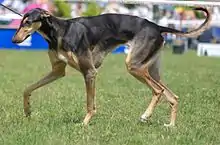Polish Greyhound
The Polish Greyhound (Polish: chart polski, pronounced [xart ˈpɔlskʲi]) is a Polish sighthound breed. It is known as the Polish Greyhound, although it is not a direct relative of the Greyhound dog.[1][2][3]
| Polish Greyhound | |||||||||||||
|---|---|---|---|---|---|---|---|---|---|---|---|---|---|
 A male Polish Greyhound | |||||||||||||
| Other names | Polish Sighthound Chart Polski (Polish) Polnischer Windhund (German) | ||||||||||||
| Origin | Poland | ||||||||||||
| |||||||||||||
| |||||||||||||
| Dog (domestic dog) | |||||||||||||
History
The first records for the existence of greyhounds in Poland come from the times of Gallus Anonymus.[4] 12th century[5] or 13th century is considered the beginnings of the breed's existence. Originally these dogs were used for hunting birds - great bustards. The Polish Greyhound was the favorite dog of the Polish nobility.[5]
After World War II, breeding of this breed disappeared.[4] Hunting with greyhounds was forbidden, and greyhound dogs were liquidated. Their keeping and breeding has been covered with a special permit, and this provision still applies. From the '70s up to the twentieth century began to reproduce the breed. Contemporary Polish Greyhound breeding was started by Stanisław Czerniakowski, who bought two females - Taiga and Struska, and one dog - Elbrus, in the vicinity of Rostov-on-Don. From the association of Taiga and Elbrus, the first litter of Polish greyhounds was born.[6]
In 1989, the breed was entered in the register of the Fédération Cynologique Internationale (FCI).
Appearance
Polish Greyhounds have short, smooth fur that comes in many colors. The coat is somewhat heavier than a Greyhound. They have an undercoat that gets thicker in the winter. Polish Greyhounds have a long brush on the tail and have culottes at the rear of the thighs. The average Polish Greyhound weighs about 60 - 90 pounds, and ranges from 27 to 32 inches tall. The Chart Polski has a smooth double coat, regardless of season, which is harsh to the touch while offering excellent insulation. The breed is a persistent hunter, with a long muscular neck, unlike the Greyhound, and the head is carried high. Large almond eyes are set in a slant, and the points of the hip bones are wide apart. The hind legs move closer together when the dog is moving at a short trot: this is called 'lacing'.
Temperament
Polish Greyhounds, also called Chart Polski, are very active dogs. They are known to be protective and loyal. These dogs tend to be well-mannered and happy if trained and routinely exercised. They tend to be standoffish with strangers and are not fond of other dogs. They are good around kids, but supervision is recommended with young children.
Health Issues
The biggest health concern for these dogs are cardiomyopathy and cancer. It is recommended to get cardiac blood and urine analysis during the dog's yearly physical examination, for optimal health.
See also
References
- DK (17 October 2013). The Dog Encyclopedia: The Definitive Visual Guide. Dorling Kindersley Limited. ISBN 9781409350026. Retrieved 21 August 2018 – via Google Books.
- Mehus-Roe, Kristin (4 October 2011). Original Dog Bible: The Definitive Source for All Things Dog. i5 Publishing. ISBN 9781935484899. Retrieved 21 August 2018 – via Google Books.
- "Dia 1" (PDF). Retrieved 2018-08-22.
- Biologia. Multimedialna encyklopedia PWN Edycja 2.0. pwn.pl Sp. z o.o., 2008. ISBN 978-83-61492-24-5.
- Multimedialna Encyklopedia Powszechna WIEM edycja 2006. Young Digital Poland S.A., 2006.
- Małgorzata Szmurło, Izabela Szmurło Chart polski
Bibliography
- Eva Maria Krämer: Rasy psów. Warszawa: Oficyna Wydawnicza MULTICO, 1998, s. 294. ISBN 83-7073-122-8.
- Goleman, M., Balicki, I., Radko, A., Rozempolska-Rucińska, I. and Zięba, G., 2021. Pedigree and Molecular Analyses in the Assessment of Genetic Variability of the Polish Greyhound. Animals, 11(2), p. 353.